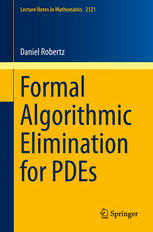
Formal Algorithmic Elimination for PDEs PDF
Preview Formal Algorithmic Elimination for PDEs
Lecture Notes in Mathematics 2121 Daniel Robertz Formal Algorithmic Elimination for PDEs Lecture Notes in Mathematics 2121 Editors-in-Chief: Jean-Michel Morel,Cachan CX Bernard Teissier,Paris AdvisoryBoard: CamilloDeLellis(Zürich) MariodiBernardo(Bristol) AlessioFigalli(Austin) DavarKhoshnevisan(SaltLakeCity) IoannisKontoyiannis(Athens) GaborLugosi(Barcelona) MarkPodolskij(Aarhus C) SylviaSerfaty(Paris) CatharinaStroppel(Bonn) AnnaWienhard(Heidelberg) More information about this series at http://www.springer.com/series/304 Daniel Robertz Formal Algorithmic Elimination for PDEs 123 Daniel Robertz Plymouth University School of Computing & Mathematics Plymouth, UK ISBN978-3-319-11444-6 ISBN978-3-319-11445-3(eBook) DOI10.1007/978-3-319-11445-3 SpringerChamHeidelbergNewYorkDordrechtLondon LectureNotesinMathematicsISSNprintedition:0075-8434 ISSNelectronicedition:1617-9692 LibraryofCongressControlNumber:2014952682 MathematicsSubjectClassification(2010):12H05,13N10, 16S32, 35C05 ©SpringerInternationalPublishingSwitzerland2014 Thisworkissubjecttocopyright.AllrightsarereservedbythePublisher,whetherthewholeorpartof thematerialisconcerned,specificallytherightsoftranslation,reprinting,reuseofillustrations,recitation, broadcasting,reproductiononmicrofilmsorinanyotherphysicalway,andtransmissionorinformation storageandretrieval,electronicadaptation,computersoftware,orbysimilarordissimilarmethodology nowknownorhereafterdeveloped.Exemptedfromthislegalreservationarebriefexcerptsinconnection with reviews or scholarly analysis or material supplied specifically for the purpose of being entered and executed on a computer system, for exclusive use by the purchaser of the work. Duplication of this publication or parts thereof is permitted only under the provisions of the Copyright Law of the Publisher’slocation,initscurrentversion,andpermissionforusemustalwaysbeobtainedfromSpringer. PermissionsforusemaybeobtainedthroughRightsLinkattheCopyrightClearanceCenter.Violations areliabletoprosecutionundertherespectiveCopyrightLaw. Theuseofgeneraldescriptivenames,registerednames,trademarks,servicemarks,etc.inthispublication doesnotimply,evenintheabsenceofaspecificstatement,thatsuchnamesareexemptfromtherelevant protectivelawsandregulationsandthereforefreeforgeneraluse. While the advice and information in this book are believed to be true and accurate at the date of publication,neithertheauthorsnortheeditorsnorthepublishercanacceptanylegalresponsibilityfor anyerrorsoromissionsthatmaybemade.Thepublishermakesnowarranty,expressorimplied,with respecttothematerialcontainedherein. Printedonacid-freepaper SpringerispartofSpringerScience+BusinessMedia(www.springer.com) Preface Thismonographoriginatesinmyhabilitationtreatise.Thethemeistounderstand thecorrespondencebetweensystemsofpartialdifferentialequationsandtheirana- lyticsolutionsfromaformalviewpoint.Weconsiderontheonehandtheproblem ofdeterminingthesetofanalyticsolutionstosuchasystemandontheotherhand thatoffindingdifferentialequationswhosesetofsolutionscoincideswithagiven set of analytic functions. Insight into one of these problems may advance the un- derstanding of the other one. In particular, as shown in this monograph, symbolic solvingofpartialdifferentialequationsprofitsfromthestudyoftheimplicitization problemforcertainparametrizedsetsofanalyticfunctions. Twoalgorithmsarefundamentalforthiswork.Janet’sandThomas’algorithms transform a given system of linear or nonlinear partial differential equations into an equivalent form allowing to determine all formal power series solutions in a straightforwardway.Moreover,theseeffectivedifferentialalgebratechniquessolve certaineliminationproblemswhenappliedinanappropriateway.Thefirstpartof thismonographdiscussesthesemethodsandrelatedconstructionsindetail.Efficient implementations of both algorithms in the computer algebra system Maple have beendevelopedbytheauthorofthismonographandhiscolleagues. Thesecondpartofthismonographaddressestheproblemoffindinganimplicit descriptionintermsofdifferentialequationsofasetofanalyticfunctionswhichis givenbyaparametrizationofacertainkind.Effectivemethodsofdifferentgener- ality are developed to solve the differential elimination problems that arise in this context. As a prominent application of these results it is demonstrated how some familyofexactsolutionsoftheNavier-Stokesequationscanbecomputed. I would like to thank several persons for many fruitful discussions about alge- bra,aboutPDEs,andtheirconnection,andforsupportingmywork.Inparticular,I wouldliketoexpressmygratitudetoProf.Dr.W.Plesken,Prof.Dr.J.Bemelmans, Prof. Dr. C. Melcher, Prof. Dr. S. Walcher at RWTH Aachen and Priv.-Doz. Dr. M.BarakatatTUKaiserslautern.ThanksgotoProf.Dr.V.P.Gerdt(JINRDubna) and Dr. A. Quadrat (Inria Saclay), not only because I have been enjoying our col- laborations,butalsoforreadingpartsofafirstversionofthismonograph. v vi Preface InthecontextofworkonThomas’algorithm,IamgratefultomycolleaguesDr. T.Ba¨chlerandDr.M.Lange-Hegermannfortheirhelp.Moreover,weprofitedvery much from discussions with Prof. Dr. D. Wang (Paris 6), Prof. Dr. F. Boulier, and Dr.F.Lemaire(bothatUniversite´ deLille)onthistopic. Furthermore,IwouldliketothankallcolleaguesatLehrstuhlBfu¨rMathematik, RWTH Aachen, for a very nice atmosphere, and, in particular, Mr. W. Krass for linguisticadvice. Finally, I am indebted to two anonymous referees for excellent suggestions on anearlierversionofthismonograph. Plymouth,England DanielRobertz July2014 Contents 1 Introduction................................................... 1 2 FormalMethodsforPDESystems ............................... 5 2.1 Janet’sAlgorithm .......................................... 5 2.1.1 CombinatoricsofJanetDivision........................ 9 2.1.2 OreAlgebras........................................ 16 2.1.3 JanetBasesforOreAlgebras .......................... 21 2.1.4 ComparisonandComplexity........................... 37 2.1.5 TheGeneralizedHilbertSeries......................... 40 2.1.6 Implementations..................................... 54 2.2 ThomasDecompositionofDifferentialSystems ................. 57 2.2.1 SimpleAlgebraicSystems............................. 60 2.2.2 SimpleDifferentialSystems ........................... 88 2.2.3 TheGenericSimpleSystemforaPrimeIdeal ............104 2.2.4 ComparisonandComplexity...........................110 2.2.5 HilbertSeriesforSimpleDifferentialSystems............112 2.2.6 Implementations.....................................116 3 DifferentialEliminationforAnalyticFunctions....................119 3.1 Elimination ...............................................119 3.1.1 EliminationofVariablesusingJanetBases...............121 3.1.2 ComplexityReductionbymeansofaVeroneseEmbedding.128 3.1.3 EliminationofUnknownFunctionsusingJanetBases......134 3.1.4 EliminationviaThomasDecomposition .................139 3.1.5 CompatibilityConditionsforLinearSystems.............147 3.2 LinearDifferentialElimination ...............................160 3.2.1 ImplicitizationProblemforLinearParametrizations .......161 3.2.2 DifferentialEliminationusingLinearAlgebra ............165 3.2.3 ConstructingaRepresentation .........................178 3.2.4 AnnihilatorsforLinearParametrizations.................182 3.2.5 Applications ........................................186 vii viii Contents 3.3 NonlinearDifferentialElimination ............................192 3.3.1 ImplicitizationProblemforMultilinearParametrizations ...194 3.3.2 EliminationMethodsforMultilinearParametrizations .....198 3.3.3 ImplicitizationusingKa¨hlerDifferentials ................207 3.3.4 ConstructingaRepresentation .........................216 3.3.5 Applications ........................................221 A BasicPrinciplesandSupplementaryMaterial .....................233 A.1 ModuleTheoryandHomologicalAlgebra......................233 A.1.1 FreeModules .......................................233 A.1.2 ProjectiveModulesandInjectiveModules ...............235 A.1.3 SyzygiesandResolutions .............................238 A.2 TheChainRuleofDifferentiation.............................243 A.3 DifferentialAlgebra ........................................247 A.3.1 BasicNotionsofDifferentialAlgebra ...................247 A.3.2 CharacteristicSets ...................................249 A.3.3 HomogeneousDifferentialPolynomials .................253 A.3.4 BasisTheoremandNullstellensatz......................256 References.........................................................259 ListofAlgorithms ..................................................273 ListofExamples ...................................................275 IndexofNotation...................................................277 Index .............................................................279 Chapter 1 Introduction Differentialequationsareubiquitousinthemodelingofphenomenastudiedinthe naturalsciences,intheirsimulation,andinengineeringapplications.Alotofmath- ematicalresearchisdevotedtounderstandingmanydifferentaspectsofdifferential equationsandtodevelopingmethodswhichdetermine(exactorapproximate)solu- tionsofdifferentialequations. Thismonographapproachespartialdifferentialequations(PDEs)fromtheview- point of algebra and contributes algorithmic methods which allow to investigate effectivelytherelationshipofsystemsofPDEsandtheirsetsofsolutions.Employ- ing formal techniques, the focus is on polynomial differential equations and their analyticsolutions. Weborrowquiteafewconceptsfromalgebraicgeometry,whichisatheorythat evolved over centuries from the continued quest to solve algebraic equations. The contemporaryunderstandingofgeometricfactsinthiscontextisformulatedinterms of polynomial ideals, the precise connection between geometry and algebra being establishedbyHilbert’sNullstellensatz. Whenever a set of points is given by a polynomial or rational parametrization, aneliminationoftheparametersfromtheequationswhichexpressthecoordinates ofthepointsyieldsequationsthataresatisfiedbythecoordinatesofeverypointof theset.Ifthereexistsanimplicitdescriptionofthissetassolutionsetofasystem ofpolynomial equations,then elimination constructssuch adescription.Since not every such solution set admits a rational parametrization, the scope of the inverse problemhastoberestrictedinsomesense,butmethodsareknownwhichconstruct rationalparametrizationsforspecialvarieties. Thismonographdevelopsalgorithmicmethodswhichaccomplishtheanalogous elimination task for systems of polynomial partial differential equations and their (complex)analyticsolutions.ItbuildsonworkbyCharlesRiquier,MauriceJanet, JosephMillerThomas,JosephFelsRitt,EllisRobertKolchin,andothers,wholaid thefoundationofdifferentialalgebra. Agivenmultivariatepolynomial,whosecoefficientsareanalyticfunctions,isin- terpretedasaparametrizationofasetofanalyticfunctions,i.e.,everyelementofthis © Springer International Publishing Switzerland 2014 1 D. Robertz, Formal Algorithmic Elimination for PDEs, Lecture Notes in Mathematics 2121, DOI 10.1007/978-3-319-11445-3_1
